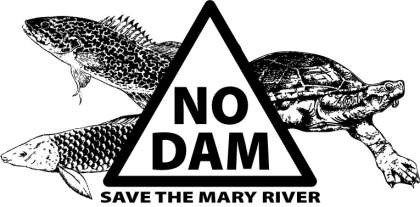SAVE THE MARY RIVER COORDINATING GROUP AND GREATER MARY ASSOCIATION
*** ** JOINT MEDIA RELEASE*** ** 30 OCTOBER 2009
It is now official - the Coordinator General’s report clearly states that the proposed Traveston Crossing dam is “not intended to supply additional water allocations for irrigation locally or throughout the wider region."
“The Coordinator General’s statement might come as a shock to some people in the community who had been led to believe by either Queensland Water Infrastructure or the Queensland Government that Traveston meant more water for local irrigators,” said Darryl Stewart, chairperson of the Greater Mary Association.
“Unfortunately we aren’t surprised by this latest broken promise from the Anna Bligh and her dam builders Queensland Water infrastructure.”
“Sunwater has contracts for 56, 000 ML/a of water now, and they seldom deliver the full amount. Being able to take another 70, 000 ML/a out of the catchment, increase local water availability and protect the ecosystem all at the same time has never added up,” said Glenda Pickersgill, president of the Save the Mary River Coordinating Group.
The Queensland Government’s submission to the Senate inquiry in 2007 stated that 10,000 ML/a would be made available locally. Several economic reports commissioned by the dam builders assumed that this water would be available and made claims of regional economic benefits on this basis. The report by Synergies Economic Consulting suggested their conclusions were “crucially dependent” on provision of this additional water.
“It’s important that the whole downstream community is aware that this means that none of the benefits to local agriculture which were alleged in earlier documents from the Queensland Government will materialize if the dam goes ahead,” said Ms Pickersgill.
A concerned Mr Stewart explained “The agricultural economy of the southern Fraser Coast is heavily dependent on water availability. The Coordinator General’s statement should be sounding alarm bells to irrigation dependent agricultural sectors in the region.”
“The same can be said for the agricultural industries downstream of the proposed dam, occupying what was formerly the Cooloola council region,” said Ms Pickersgill. “Like the Southern Fraser Coast, water is regarded as a baseline economic input for these regions.”
The Greater Mary Association is writing to Minister Garrett and Agriculture Minister Tony Burke to draw their attention to the Bligh Government’s broken promise on local water availability.
“We will ask Minister Garrett to consider the economic impact of this reduction in water availability,” said Tanzi Smith, research coordinator of the Greater Mary Association.
“We have also asked that he take into account the influence that previously misleading statements by the Queensland Government may have had on the views expressed by certain sectors in the community who thought they stood to benefit from the dam.”
“Both of these matters fall within the social and economic impacts which Minister Garrett is required to consider under the Environment Protection and Biodiversity Conservation Act,” concluded Ms Smith.
Media Contacts:
Darryl Stewart (Greater Mary Association) 041 877 1655
Glenda Pickersgill (Save the Mary River Coordinating Group) 041 144 3589
Tanzi Smith (Greater Mary Association) 040 584 8375
David Kreutz (Save the Mary River Coordinating Group) 043 268 3147


Comments
Wasted dam opportunities
THE use of wasted heat from Swanbank power station to distil sea water in huge quantities was an option the state government failed to examine before deciding on the Traveston Crossing Dam.
Report in the Sunshine Coast Daily: http://www.sunshinecoastdaily.com.au/story/2009/11/01/wasted-opportuniti...